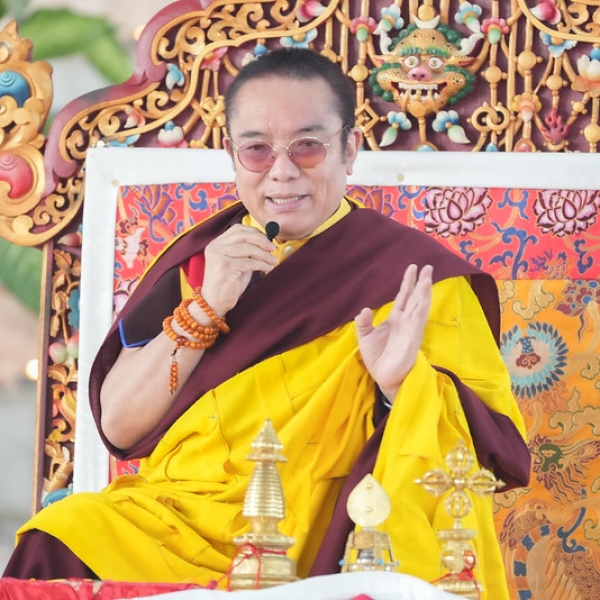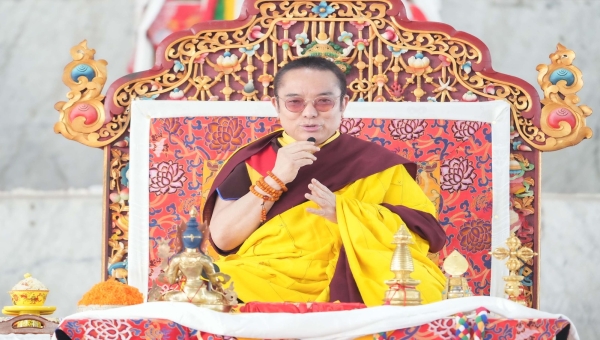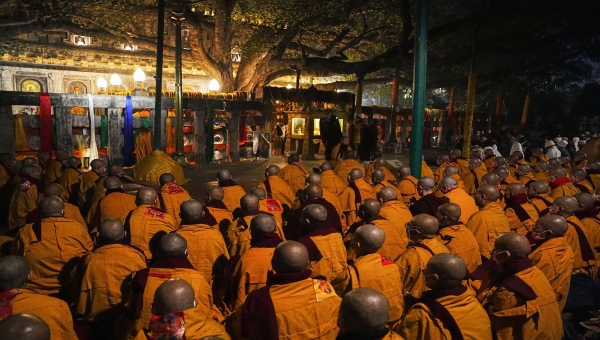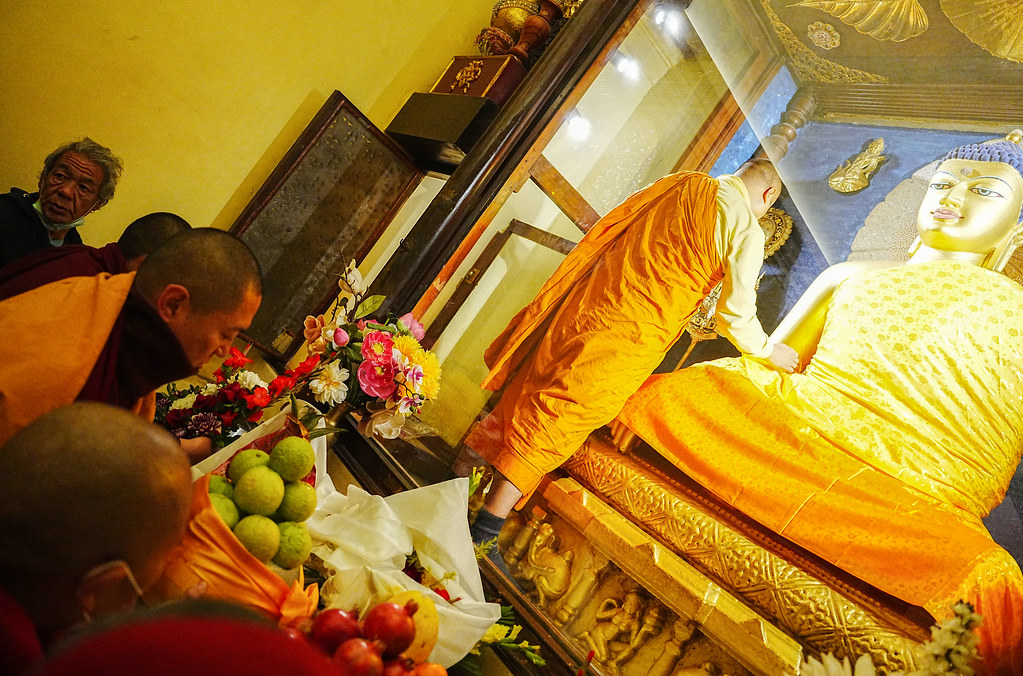Monlam Pavillion
Bodhgaya
28 January 2024
Drupon Dechen Rinpoche had requested Tai Situ Rinpoche to give some words of advice to the nuns at the inaugural ceremony of the 8th Arya Kshema. He encouraged the nuns to continue holding the Arya Kshema in the future as they had been doing previously. “Whatever you do, you have to first decide what to do, and then decide to do it,” he advised.
He said that the Arya Kshema had now been running for several years but that this was his first time to attend it, and he made the aspiration that it would be of service to the teachings of the Buddha and of benefit to all sentient beings. He reminded the nuns, “All of the dharma activities that we do are for the sake of serving the Buddhist teachings and benefitting sentient beings. There is nothing we do that is not that.”
He commended their effort in coming great distances, in spite of hardships and difficulties, and committing themselves to a month-long event:
In a single year there are only twelve months, so one month is a long time, and since it is a long time, you need to make sure that it really does what it’s supposed to do. This is the aspiration, that it happens and I’m sure that it will.
Because the meeting is called the Arya Kshema, Tai Situ Rinpoche thought he should focus more on the nuns and make aspirations applicable to nuns in particular. In his experience, and he was now 70 so he did have some experience. He had travelled the world teaching at the invitation of others, and he had also visited sacred sites and gone to teachings by great lamas. This was his observation:
From my own experience, the people who take responsibility in the dharma centres, who do the work and serve, are mostly—the majority of them— are women. They’re all women.
People often have a misperception, he suggested. Because there are more monasteries than nunneries, there are many more monks than nuns; that’s how people view it. Yet, in fact, the majority of people who serve the teachings are women:
The people who bring their children to the monastery to become monks and nuns and who give up their own personal wishes and make the effort are mostly women. There are fathers who bring their children, but more are brought by their mothers.
As to the differences between men and women:
In general, this is basically a physical difference. It’s not as if there is a separate male mind and a different female mind. They are not separate. They are not different. Both have the basis of Buddha nature, the essence of the Buddha, and they are both the same. In addition to that, since women are by nature prajñā, they are generally more intelligent. Of course, there are men who are intelligent, but many different texts state that women are more intelligent. And it’s also very clear in the tantras. Among the 14 root downfalls of samaya, the fourteenth is disdaining the essence of the nature of wisdom – women. So, whoever disdains or scorns women, who are of the nature of wisdom, incurs the fourteenth root downfall of samaya.
As most of the nuns at the Arya Kshema were students in the shedras, studying the five great philosophical texts—the Middle Way, Prajnaparamita, the Abhidharma, the Vinaya, and Epistemology and Logic—Tai Situ Rinpoche now talked about the purpose of shedras and debate:
Debate is a way to hone your knowledge of the Buddha’s teachings in order to understand them within a short time. You study the texts on logic written by the great beings and you take them as the path you follow. These texts extract the most important points from the main texts and present them in a way for you to debate. The reason for engaging in logic is not to leave you with a lot of doubts but in order to eliminate your doubts, to follow the process through, so that you come to determine fully what the actual valid, authoritative meanings of the Buddhist Scriptures are. This is what we mean when we say ‘teaching, debating, writing’.
As the nuns are part of the Buddhist Sangha, and the Sangha is one of the three objects of refuge in Buddhism, the nuns needed to live up to that name. They needed to develop qualities by engaging in teaching, debating, writing, and listening, contemplation, meditation, and by keeping excellent conduct. This was the purpose of shedras, and the purpose of becoming a monk or nun. He pointed out that when people became monks or nuns, it was not because they were frightened by the responsibilities of life as a parent or householder or because they hoped to live off other people’s offerings. It was because the life of a householder is limited. Householders make an important contribution to the lives of their children but lack the freedom to free themselves from the lower realms, to achieve nirvana and to work for the benefit of all sentient beings. Parents might have up to a maximum of twenty children that they care for, but monks and nuns should regard all seven billion people in the world as if they were their own children and work for their benefit. Not just that, they should remember all sentient beings throughout space in the six classes of samsara and the three times:
The Bhagavan first aroused the mind of bodhicitta, accumulated merit for three innumerable aeons, and then achieved buddhahood. It is in order to be able to follow his example that we become monks and nuns. It is not like worldly people doing everyday things which everyone knows how to do…
We are the Mahayana Sangha, the Vajrayana Sangha. We need to know what it is that we need to do. All of us, whether khenpo or teacher or student, are upholding the lineage of the buddha’s teachings, which have continued for 2600 years without breaking. We are also in the Marpa Kagyu tradition. However, here we need to be mindful otherwise we might end up having bias and sectarianism. We have the opportunity to enter the Buddha’s teachings, but we shouldn’t just be concerned for our own tradition otherwise that is bias, and that is worse than having worldly attachment and aversion.
The Buddha taught the Buddhadharma for the sake of all sentient beings; to be partisan and biased is to go against the intention of the Buddha and the true Dharma. It’s a grave misdeed, a huge obscuration.
Tai Situ Rinpoche referred to defaced and mutilated religious images found at Buddhist pilgrimage places as an example of the destructive power of attachment and aversion. In Tibet, the teachings had flourished at first during the first transmission, but they also declined rapidly and much had been lost. Citing the work of the grammarian Thonmi Sambhota (7th century), he had composed eight works on grammar but only two remain: the Thirty Verses and the Application of the Signs.
These two texts had made it possible for Tibetans to communicate with each other and understand the meaning of the written word, given the myriad regional dialects and diverse pronunciation in Tibet, which sometimes differ even from valley to valley.
Similarly, there had been the eight great practice lineages in Tibet, but much had been lost or assimilated, for example there was no longer an independent Shangpa Kagyu lineage and the Jonangpa have had great difficulties. This is a sign of the decline of Buddhism in Tibet.
We need to focus our attention during this Arya Kshema Spring Teachings and ensure that the teachings of the Buddha remain long. We need to hone our understanding by engaging in debate until we come to the main point, which is to understand them.
Rinpoche then spoke on the gelongma issue:
Many people say that there are no gelongma vows [in Tibet] anymore. However, there are some great lamas who have given the vows…My own root guru Karmapa Rigpe Dorje, many years ago, thought about this, and sent his student Freda Bedi to Hong Kong to take the gelongma vows. He did this in order to revive the gelongma tradition. After my teacher passed away, I was unable to keep it up, but I did continue sending many of our nuns abroad to take their gelongma vows, as this was the example set by my root guru. There were many nuns who took the gelongma vows; though many have passed away, there are still a few alive. I was unable to revive the gelongma lineage myself. However, whether we are able to restore it or not, eventually, when people have merit, if you have real resolve and faith and devotion in the dharma, then we can definitely revive the gelongma ordination.
Rinpoche summarised the great lineage which the nuns, whether gelongma or getsulma, are responsible for upholding:
We are all followers of the Buddha. Among them, if we count back 1500 years, we are all followers of Tilopa, Naropa, and Marpa. Marpa’s student was Milarepa, Milarepa’s student was Gampopa, who had four main students. One of them was the first Gyalwang Karmapa Dusum Khyenpa. So, we are followers of his. When we say the Karma Kagyu, the Karma Kamtsang, this means that we are in the lineage of the first Karmapa, that is why we are called by this name.
Marpa Lotsawa said that just like the lion’s cubs and the garuda’s hatchlings, the students will surpass their teachers. What this means is that in the lineage of lions or of garudas, their offspring always get better and better. When a garuda is in the egg it already has all its six types of strength and as soon as it hatches it is able to fly. They are different from other birds. We don’t see them in these degenerate times, but this is how it was, and it actually happened. Marpa Lotsawa went to India three times and spent twenty-one years there, and he spent sixteen years and seven months in the presence of his guru undergoing hardships, requesting teachings, and practising dharma. Then he brought it back and taught the dharma to his students. He had many students – Lama Ngok Chöku Dorje, Milarepa - and many others. In terms of upholding the teachings, the transmissions and the explanations were passed to Ngok Chöku Dorje, and the transmissions and the practice were passed to Milarepa.
The essence of the teachings and the practice are the same. Because of Milarepa’s unparalleled hardships and diligence, he achieved the highest siddhis. Because of that, he had students—Rechungpa, the peerless Gampopa, and uncountable others. Among them, Gampopa was different. He was the confluence of the rivers of Kadampa and Mahamudra, which passed down through Gampopa and his nephews, to Dusum Khyenpa, and likewise to Phagmo Drupa Dorje Gyalpo, Barompa Darma Wangchuk, and Zhang Tselpa. These were the founders of the four elder Kagyu lineages. The eight younger lineages were descended from the Phagdru Kagyu: Drikung, Taklung, Trophu, Lingre, Yabzang, Shugseb, Martsang and Yelpa. When we say that the students will surpass their teachers, it means that the teachings will spread and flourish, and the teachers weren’t displeased by this.
In the future, the seven types of pratimoksha vows must all be present. We need them to be complete and spread and flourish.
Rinpoche then revisited the theme of the qualities and importance of women:
“All my mothers, all sentient beings throughout space”, we don’t say “All my fathers.” This is not because we are scorning fathers but because mothers are by nature prajñā, and mothers work harder on our behalf. Mothers naturally have loving kindness. They naturally have love for their children and by this we mean the wish for their children to be happy. “May my child be happy and comfortable.” They work hard for this, even if they have to sacrifice their own life for the sake of their child. This is the type of love they have. They have loving kindness, compassion, sympathetic joy. They have all four of the immeasurables, but their strongest one is loving kindness. This is the characteristic of a mother, that’s right, isn’t it?
If we made a heap from the bones of all our mothers, its size would be greater than a million earths. Likewise, all our mothers from all our past lives have worked very hard for us. They have worried about us and cried over us, when they thought we were not doing well. If we consider the volume of tears they have shed, it would be even greater than the four great oceans. This is how important our mothers are.
He explored what it actually means to hold the aspiration “My mothers, all sentient beings throughout space…” which we recite continuously in dharma texts.
This is not just something we are simply reciting. When we make aspirations in dharma, most of them are really vast, but putting these vast aspirations into practice is really hard. We say “all sentient beings throughout space” in our aspirations but, although this is something we can imagine, it is not something which we can actually put into practice. There is no end to space. Sometimes we don’t quite understand the term ‘space’. People think of space as the blue sky, but this only covers half the world. It’s only there in the daytime not in the nighttime. We have to consider all sentient beings who are in innumerable universes “as vast as space” not “as vast as the blue sky”. We mean all-pervading space…the blue sky is too small. All-pervading space is limitless and endless. This is how we need to think.
And what should our aspiration be?
For all sentient beings to live long, for their activity to spread, for their minds to turn to the Dharma, for the Dharma to become the path, for the path to dispel confusion, and for confusion to arise as wisdom.
Finally, Tai Situ Rinpoche reminded the nuns that the Arya Kshema didn’t just happen but was dependent on the generosity of sponsors, who had worked hard to earn the money which they then used to make an offering to serve.
All members of the sangha are sustained by the offerings people make. Milarepa said he was always afraid of the offerings, and Situ Rinpoche agreed that they could be quite frightening. The danger was that they could be a cause for obscurations to arise or strengthen. Sangha members might become prouder, greedier, or angrier because of them. Rinpoche urged the nuns to engage in practice, the accumulation of merit and the purification of obscurations, in every minute of every day, in order to avoid this.
It was crucial for members of the sangha to keep their attention focused, to be mindful, aware and careful, otherwise they could go around in circles or in the wrong direction.























